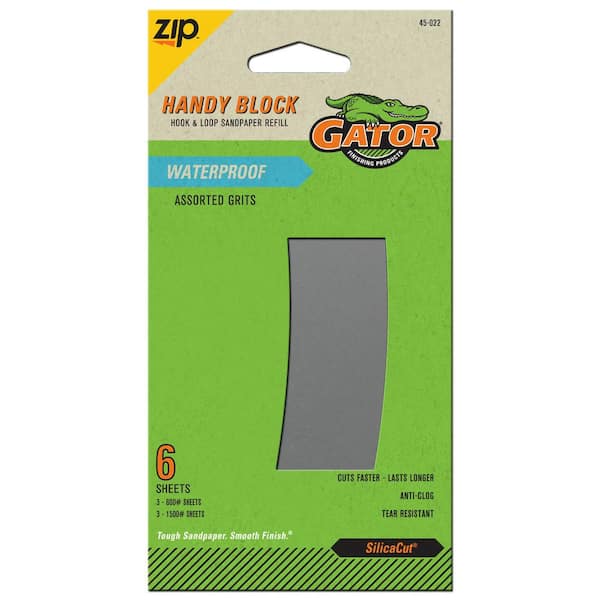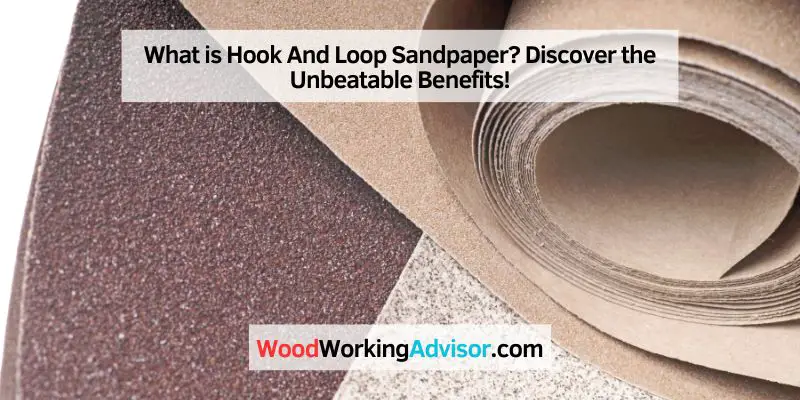Hook and loop sandpaper is an abrasive material that uses a fastening system of hooks and loops to attach to a power tool or sanding block, providing a secure and efficient sanding surface. Hook and loop sandpaper, also referred to as Velcro sandpaper, is a commonly used abrasive material in various industries and DIY projects.
It is designed with tiny hooks on one side and loops on the other, allowing for easy attachment and removal from compatible tools and devices. This type of sandpaper provides a strong grip, preventing slippage during sanding tasks and enabling quick and hassle-free sheet changes.
With its versatility and ease of use, hook-and-loop sandpaper is a popular choice for professionals and DIY enthusiasts seeking excellent sanding results.
The Basics Of Hook And Loop Sandpaper
Hook and loop sandpaper, also known as Velcro sandpaper, features a backing with tiny hooks and loops that grip onto a sanding pad. This makes it easy to remove and change the sandpaper, improving work efficiency and saving time.
What Is Hook And Loop Sandpaper?
Hook and loop sandpaper, also known as Velcro sandpaper, is a type of abrasive material used for sanding and polishing surfaces. It consists of a backing pad with loops that attach to the abrasive material, which has hook-like protrusions. This innovative design allows for quick and easy swapping of sandpaper discs, making it a convenient choice for both professionals and DIY enthusiasts.
How Does Hook And Loop Sandpaper Work?
Hook and loop sandpaper works by utilizing the hook and loop connection system. The backing pad of the sanding tool is equipped with loops, while the sandpaper itself has hook-like protrusions. When the sandpaper is pressed onto the backing pad, the hooks latch onto the loops, creating a secure and stable bond.
- This bond ensures that the sandpaper stays in place while sanding, preventing any slippage or movement.
- When it comes time to replace the sandpaper, simply pull it off the backing pad and attach a new one.
- This quick and easy process saves time and effort, allowing users to seamlessly transition between grits or switch out worn-out sandpaper.
Hook and loop sandpaper is available in various grits, allowing users to choose the appropriate level of coarseness for their specific sanding needs. Whether you are working on woodworking projects, metal surfaces, or even automotive repairs, hook-and-loop sandpaper provides the versatility and convenience required for efficient and effective sanding.
The Unbeatable Benefits Of Hook And Loop Sandpaper
When it comes to sanding surfaces, hook-and-loop sandpaper offers a range of unbeatable benefits. This innovative sanding tool is designed with a unique fastening system that ensures easy and efficient sandpaper changes. In this article, we will explore the time-saving advantage and the versatility and reusability of hook and loop sandpaper.
Time-saving Advantage
One of the significant advantages of using hook-and-loop sandpaper is its time-saving capability. With the traditional adhesive sandpaper, you would have to peel off the old sandpaper, clean the adhesive residue, apply new adhesive, and wait for it to dry before proceeding with your sanding process. This tedious and time-consuming process can be eliminated with hook-and-loop sandpaper.
Versatility And Reusability
Hook and loop sandpaper offers versatility, allowing you to use the same sanding block or power tool with different grits of sandpaper. The hook and loop attachment system securely holds the sandpaper in place, ensuring that it stays firmly attached during the sanding process. This feature allows you to switch between grits quickly and easily, without the need for specialized tools or equipment.
Furthermore, hook-and-loop sandpaper is reusable, providing long-term cost savings. After using the sandpaper, simply remove it from the sanding block or power tool and clean it to remove any debris or dust. This enables you to reuse the sandpaper multiple times, reducing waste and saving money on replacements.
In addition to its time-saving and reusability benefits, hook-and-loop sandpaper also provides consistent and uniform sanding results. The secure attachment ensures that the sandpaper remains in place throughout the sanding process, resulting in more efficient sanding and a smoother finish.
The unbeatable benefits of hook-and-loop sandpaper make it a valuable tool for any sanding project. From DIY enthusiasts to professional contractors, its time-saving advantage, versatility, and reusability make it an essential addition to any toolkit. Say goodbye to the hassle of traditional adhesive sandpaper and experience the convenience and efficiency of hook-and-loop sandpaper for your next sanding task.
How To Properly Use Hook And Loop Sandpaper
Sanding surfaces requires the right tools and techniques to achieve a smooth and polished finish. When it comes to using hook-and-loop sandpaper, it’s essential to follow the proper steps to ensure effective sanding and prevent any mishaps.
Preparing The Sanding Surface
Before starting the sanding process, it’s crucial to properly prepare the surface to be sanded. This includes cleaning the surface thoroughly to remove any dirt, dust, or debris. Ensure the area is smooth and free of any imperfections for a more effective sanding process.
Attaching And Replacing The Sandpaper
When using hook and loop sandpaper, it’s important to securely attach the sandpaper to the sanding tool. Align the hooks of the sandpaper with the loops on the sanding tool, ensuring a secure and snug fit. When the sandpaper begins to wear out or becomes less effective, it’s essential to replace it promptly to maintain the quality of the sanding job.

Credit: www.homedepot.com
Choosing The Right Hook And Loop Sandpaper Grit
When it comes to achieving the best results in your sanding projects, choosing the right hook and loop sandpaper grit is crucial. The grit number refers to the size of the abrasive particles on the sandpaper, with higher numbers indicating finer grits. In this section, we will explore the significance of understanding grit numbers and how to select the appropriate grit for your specific task.
Understanding Grit Numbers
Grit numbers range from coarse to fine, with each number corresponding to a specific particle size. Lower grit numbers, such as 40 or 60, have larger abrasive particles and are ideal for heavy material removal or shaping surfaces. Higher grit numbers, such as 120 or 220, have smaller particles and are suitable for fine finishing and smoothing.
The following table provides an overview of common grit numbers and their recommended applications:
| Grit Number | Recommended Application |
|---|---|
| 40-60 | Heavy material removal, shaping surfaces |
| 80-100 | General-purpose sanding, leveling surfaces |
| 120-220 | Fine finishing, smoothing surfaces |
Selecting The Appropriate Grit For The Task
When selecting the appropriate grit for your task, consider the material you’re working with and the desired outcome. Here are some general guidelines:
- Use a coarse grit (40-60) for rapid material removal, such as stripping paint or sanding rough wood.
- For general-purpose sanding and leveling uneven surfaces, opt for a medium grit (80-100).
- When you need to achieve a smooth and polished surface, choose a fine grit (120-220).
It’s important to note that the choice of grit can vary depending on the project. For instance, if you’re sanding a delicate surface or working on a small area, you may want to start with a finer grit to avoid excessive material removal.
In conclusion, understanding grit numbers and selecting the appropriate grit for your hook and loop sandpaper can make a significant difference in achieving the desired results. By considering the material and task at hand, you can ensure a smoother and more efficient sanding experience.
Maintaining And Storing Hook And Loop Sandpaper
Hook and loop sandpaper is a type of sandpaper that is widely used for its convenience and effectiveness. It features a hook-and-loop fastening system that allows the sandpaper to be easily attached and removed from the sanding tool. To optimize the performance and lifespan of your hook and loop sandpaper, it is important to properly maintain and store it. In this article, we will discuss two important aspects of maintaining and storing hook and loop sandpaper: cleaning the sandpaper and proper storage techniques.
Cleaning The Sandpaper
Cleaning the sandpaper regularly is essential to ensure its longevity and efficiency. Here are some simple steps to help you clean your hook and loop sandpaper:
- Use compressed air: Start by using compressed air to remove any loose particles and dust from the sandpaper surface. This will help prevent the debris from clogging the abrasive material.
- Gently brush the surface: Take a soft-bristle brush and gently brush the surface of the sandpaper. This will help remove any remaining dust or particles that were not removed by the compressed air.
- No chemicals: Avoid using any harsh chemicals or solvents to clean the sandpaper, as they can damage the abrasive material. Stick to using only a brush and compressed air for cleaning purposes.
Proper Storage Techniques
Properly storing your hook and loop sandpaper is crucial to prevent it from getting damaged or losing its effectiveness. Follow these storage techniques to keep your sandpaper in optimal condition:
| Technique | Description |
|---|---|
| Use a sandpaper organizer | Investing in a sandpaper organizer can help you keep your sandpaper neatly organized and protected. These organizers typically have separate compartments for different grits, making it easy to find the sandpaper you need. |
| Keep it dry | Moisture can cause the sandpaper to deteriorate quickly. Ensure that your sandpaper is stored in a dry area to prevent any moisture buildup. |
| Avoid extreme temperatures | Extreme temperatures can also negatively impact the quality of your sandpaper. Avoid storing it in areas that are excessively hot or cold to maintain its performance. |
| Separate grits | If you have sandpaper with different grits, it is important to store them separately. This will prevent any contamination between different grits and ensure that each piece remains effective. |
| Protective sleeves or boxes | If you prefer to store your sandpaper in sleeves or boxes, make sure they are sealed properly to prevent dust and debris from entering. |
By following these simple cleaning and storage techniques, you can prolong the lifespan of your hook-and-loop sandpaper and ensure that it remains effective for your future sanding projects.

Credit: taytools.com
Frequently Asked Questions For What Is Hook And Loop Sandpaper
What Is The Difference Between Hook And Loop And Stick On Sandpaper?
Hook and loop sandpaper uses a system of interlocking loops and hooks for attachment, making it easy to remove and reuse. Stick on sandpaper has a sticky backing that adheres securely to the surface. Hook and loop is more versatile, while stick-on sandpaper is convenient for one-time use.
What Is Hook And Loop Fixing Sandpaper?
Hook and loop fixing sandpaper is a type of abrasive material that features a hook backing and a loop surface. This design allows for easy and secure attachment to compatible sanding tools, offering convenience and efficiency during sanding tasks.
How to Do Hook And Loop Sanding Sheets Work?
Hook and loop sanding sheets work by attaching to the sanding pad with their interlocking design. This allows for easy and quick changes during sanding, increasing efficiency. The hook and loop system secures the sandpaper firmly in place, preventing slippage during use.
Which Is Better Hook And Loop Or PSA?
Hook and loop is better for temporary applications, while PSA (Pressure Sensitive Adhesive) is ideal for permanent ones. The choice depends on the duration and strength required for your specific needs.
Conclusion
Hook and Loop sandpaper is a versatile and efficient tool for various sanding applications. Its interchangeable nature allows for quick and easy grit changes, saving time and effort. Its strong grip ensures a secure hold, resulting in smoother and more precise finishes.
Embracing this sandpaper can significantly improve your sanding experience.


